Picture: Photography workshop participants shooting the sunset at the Point Reyes Headlands, Point Reyes National Seashore, Marin County, California – (All of the pictures in this post were taken of participants working in the field during my most recent “Point Reyes On-Assignment” Photography workshop.)
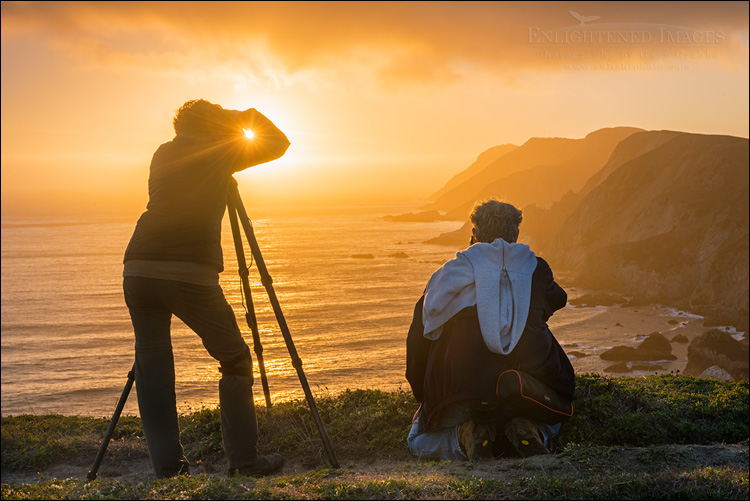
Should instructors also take pictures when leading photography workshops?
Let’s start with the question, “Do I take pictures when I’m leading photography workshops?
The short answer is, “Yes.”
This is something I definitely have an opinion about. With the boom of digital photography and the subsequent explosion in offerings for photography workshops, I’ve seen and heard stories of photographers leading photography workshops who seem more focused on using the workshops as an excuse to pursue or fund their own photography goals. From the stories I’ve heard, this always seems to come at the expense of a diminished quality teaching experience for their students. I’ve seen a well-known ‘Name’ photographer who promotes workshops with an emphasis on small groups and personal attention, yet over a 30 minute period, never left his tripod while students milled about or had to go to the instructor in order to ask a question. To me, this is the antithesis of what a quality workshop experience should be. Simply put, if an instructor isn’t ‘Making the Rounds’ to speak to individual participants while they’re shooting in the field, then said workshop leader isn’t doing their job very well.
I also know people who take the extreme opposite approach, and refuse to photograph anything while teaching so they can devote an absolute 100% of their attention to the students. And while strongly I agree with the ethics and principle of their approach, I don’t wholeheartedly agree in practice or practicality.

At the start of every class I teach, I explain that I will be taking some pictures along the way. But the one thing I never want to get is a participant review which said, “he spent all his time taking his own pictures.” Let’s face it, in a workshop, students are the priority. Period. I’m being paid by them to teach them. Period.
So how to balance this delicate equation? I say right up front that I will be taking pictures along the way under the following circumstances and for the following reasons. (In order of frequency, most to least.)
(1) I’ll be taking pictures of them. After all, they’re the stars of the show. (Hence all the images shown here.) Also, when it comes time for the review session, I believe the participants really enjoy seeing themselves in the shots I’ve taken during the course of their workshop experience.
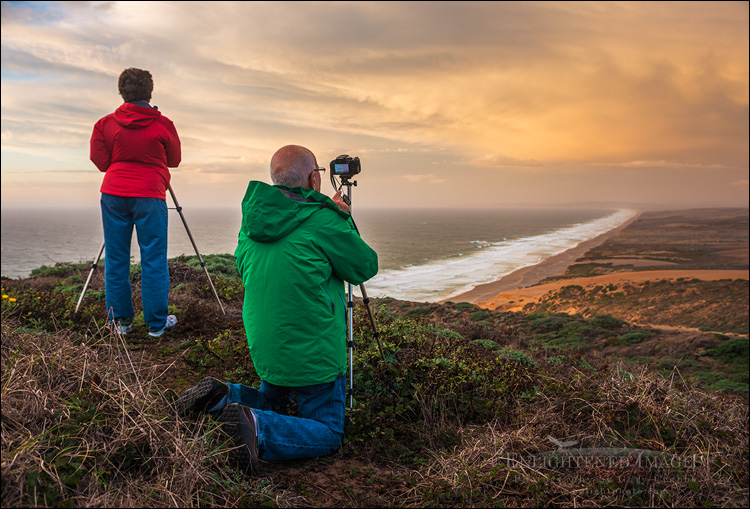
(2) I’ll conduct in-field demonstrations of shooting techniques using my equipment.
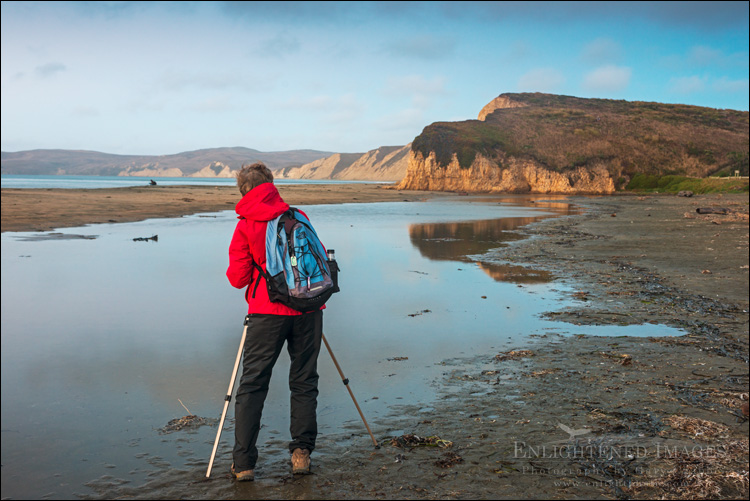
(3) When it comes time for group review and critique, I feel it’s a helpful learning tool to show a few examples of how I see or capture a scene, especially when it’s at the same time, location, and conditions where the student was participating. You can explain how you see a scene on location, but showing them a picture of how I saw the scene is part of the learning experience, and worth a thousand words. This is where I disagree on the point of refusing to shoot while teaching. As a pro, I know I can quickly shoot a few example frames of each scene for a critique and review session without it impeding my ability to keep the participants as my priority.
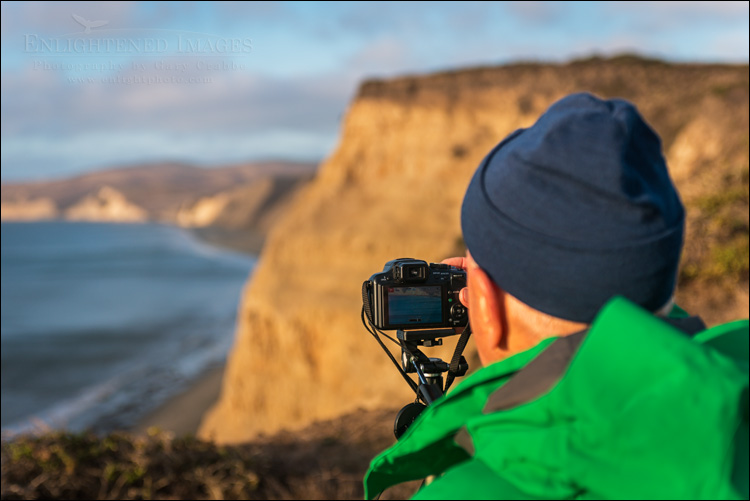
(4) And finally, there will be times and conditions are SO good or SO unique, I simply, as a photographer, have to take a shot because the moment is TOO GOOD to let pass. I’ll be sure to let my students know when these moments occur. On occasion, I’ll tell my students to pause and take a moment to reflect on the magnificence and beauty that surrounds us. I feel it’s important we don’t ‘lose the moment’ for the sake of recording it. The act of photography can become akin to what people in theater call an Invisible Fourth Wall. The act of doing creates a mental barrier to experiencing; actively, simply, experiencing. These are what I call SARR moments: Stop. Absorb. Reflect. Resume.
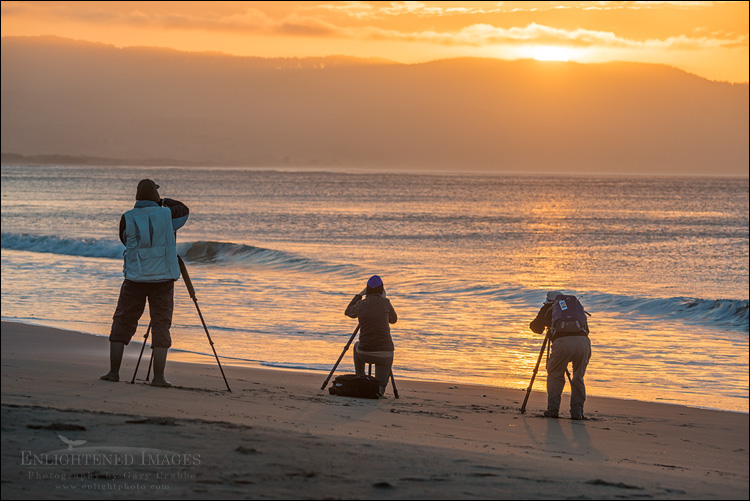
So, what do you think about whether photography workshop instructors should be taking photos while leading workshops? And if you do think it’s OK, especially if you’ve been a participant or student in any workshops, what percentage of time do you think is reasonable for an instructor to be taking photos alongside the participants? I’d love to hear your thoughts and opinions. Also, if you’ve got any good ‘horror stories’ – feel free to share, but please don’t include any names.
OK, let’s end with the question, “How much time do I think is reasonable for an instructor to be taking photos alongside the participants?”
My Answer: Excluding demonstrations or photographing the participants in action, I try to limit my own time with a camera to about 10-15% or less. That is certainly ample enough time for me to get a few personal example shots of any location to use in the review session or to keep for my own files.
—
![]()
If you like this post , I would greatly appreciate it if you’d consider sharing this with your friends using one of the Social Media sharing buttons located at the top of this post. You can also sign up to receive free updates by email when future posts are made to this blog.
![]()
—
![]()
—
Gary Crabbe is an award-winning commercial and editorial outdoor travel photographer and author based out of the San Francisco Bay Area, California. He has seven published books on California to his credit, including “Photographing California; v1-North”, which won the prestigious 2013 IBPA Benjamin Franklin Gold Medal award as Best Regional title. His client and publication credits include the National Geographic Society, the New York Times, Forbes Magazine, TIME, The North Face, Subaru, L.L. Bean, Victoria’s Secret, Sunset Magazine, The Nature Conservancy, and many more. Gary is also a photography instructor and consultant, offering both public and private photo workshops. He also works occasionally a professional freelance Photo Editor.



I agree with you, Gary. Having seen you first-hand I’d say you accurately describe your process here and have a great balance. In-fact I’d probably say you err on the side of hardly shooting much at all as your focus is 100% on teaching. It’s good to come away with a few examples for students to compare against later on so they can see your teaching put into practice that they can relate to since they were there alongside you.
In the photo tours (not “workshops”) that I’ve been leading, I’ve noticed that the participants were always interested in seeing what I had shot. I would think that part of the appeal of traveling with a photographer you admire is to see how he works.
I lead dozens of workshops each year and I always bring my photography gear into the field with my clients. I do this for a number of reasons. First, I some times use my own gear to illustrate a technique that is best taught by showing rather than only telling. I’m most familiar with my own gear and thus I am able to do the demonstration without fumbling over equipment. Second, I some times loan out my own gear to my clients. And third, as I tell my clients, if Elvis flies by on a unicorn below a double rainbow I don’t want to miss the shot. That is to say that if the conditions are all-time epic, I will ask my client’s permission to make a quick photo or two before returning my undivided attention to them.
I have seen countless workshops in the field where the instructor shows everyone where to put their tripod and then disappears to pad his own portfolio. This is unacceptable to me. Sadly, it happens all the time.
Gary, I tend to think — as it seems that you do, judging from the article — that it is a matter of balance and intent. I’ve also heard those stories of workshop instructors who were too busy with their own photography and left paid participants feeling that they were left to fend for themselves… and perhaps mostly there to allow the instructor to do some photography.
(I’ll never forget a couple I ran into in the Yosemite high country some years back. After hearing them discussing a problem, I offered some basic thoughts on the issue and moved on. Later we met again at their car, I mentioned my name, they knew of my photography… and they unloaded about the workshop they were coming home from. Apparently there was supposed to be food, but there wasn’t. Apparently they felt abandoned when the teachers went off to shoot on their own rather than paying attention to their clients.)
I can’t imagine anyone objecting to an instructor (or assistant) capturing some shots of the participants to share with them later — in fact, I’ll bet they love seeming these photographs. I also think that doing a “here’s how I would shoot this” for real, by setting up and narrating the process and thinking, is a fine idea. I can envision situations in which there could be moments of shooting side-by-side with the participants.
I suppose it is also a matter of teaching style. I know of some folks who are fine workshop teachers who keep their cameras put away all the time — but nearby for quick retrieval if necessary!
The article shares one other important bit of information for anyone taking a workshop — an example that they can compare to when thinking about what happened in workshops they attend.
Dan
http://www.wildshots.ca/2009/06/secrets-of-the-photo-workshop-business/
Great article Gary, and I tend to agree.
There is a fine line between a workshop and a tour though. Some advertise themselves as tours and then mention the word “workshop” in the blurb – this can be very confusing for people and create inappropriate expectations.
I guess if you’re clear from the start that it’ a workshop then the focus should always be the students.
That being said, if an amazing scene presents itself, people can learn just as well from watching the instructor “doing” as well as listening.
Keep up the great work.
Neil
If you can get away with shooting for yourself while conducting a workshop, that’s fine I guess, and you and some of the other commenters make some plausible rationalizations for doing it. But I really like the idea of a teacher who is willing to sacrifice his own photo opportunities — even the Golden Elvis moments — to devote attention to the students. Either way, if you are up-front with the clients about your plans, I think you’re in good shape. I also think using a hand-held camera to capture the students’ experiences in the field is a great idea — fun for them and for you.
Gary, here’s my two cents as a participant in one of your workshops. I can understand the various points made here. My point of view is that, as the student, I am there to learn from a professional – not do more solo practice. At the same time, I did find your sharing of your own images, from the same place, time, and conditions, to be very helpful. It’s even helpful to watch the professional in action, seeing how they handle their gear.
You were readily available to answer questions from any of us, in fact you encouraged it. So I felt you maintained a good balance of giving the students space to find their vision (while making some photos of your own) vs being available to help.
I would *not* be happy if I attended a workshop and the instructor disappeared to focus on their own work. That would be like taking a university class, and instead of teaching the class, the professor went to the library to do research while the students were left to just read on their own (what would be the point of the class).
I totally agree with you, Gary. As a participant in a workshop, I would expect the pro to be available for questions, and to check on my composition, exposure, etc. As an instructor, I believe my students have that same right. If I take photos, it is only when the opportunity is there and I have “made the rounds.”
Very interesting subject – thanks for opening the discussion.
One of the ways workshop participants learn is by watching how the instructor shoots. I teach photo workshops and take people on private photo tours and always take pictures. Sometimes I only have time to take time to take a few shots because I also always help people with camera and tripod settings as well as check out the images they are getting on the back of the camera. Shooting with a pro is part of the learning experience and peoples’ experience with you.
I’ve been teaching workshops since the early1970s to students of all ages and all levels of proficiency. If found that different students have different expectations and a lot depends on the subject I’m teaching. For instance, in my large format workshops, I used to give demonstrations that required me to select an appropriate subject, set up the camera, make required adjustments and make a picture (usually on Polaroid film) that would simulate the anticipated result. However, I only did this for demonstration purposes and I did not use my students’ time to make pictures for myself. The objective was always to devote most of my time to working with the students in groups or one-on-one, sometimes letting the students work in pairs and share their learning experiences. Workshops, I believe, are all about the students and their work and not about me. My job is to help each workshop participant achieve their objectives.
There’s a difference between a “Workshop” and an “Outing,” both of which can be intense learning experiences. I also go on outings or photo hikes with people who want to share experiences with me. Teaching, in that case, is done by example. I will talk with my participants and help them see opportunities they might not see without a bit of coaching. Then, once they see a composition that excites them, I’ll encourage them to make the picture. When they ask if I’m also going to make the picture, my response generally is, “No, it’s your picture now.
My workshops now are all about digital photography, and my methods have changed, but it’s still all for and about the students. I reserve personal photography for my personal time, although I will take “snaps” of my students at work now and then.
There isn’t an absolute yes or no answer to your question, Gary. If letting a student watch you make an image will help that individual improve their technique or vision, I’d do it. If you can achieve the desired result and make them comfortable by coaching them while they work with their own equipment, then that is the approach you might prefer. You may have noticed that you can go on an outing with ten students, introduce them to the same subject matter and—more often than not—get ten different results. It’s all part of the fascination of teaching.
Gary, these are excellent points, and I agree with you. I think the leader should spend some time taking pictures to show us what he sees and how he sees it — which is especially useful while we are there, as well as later in a critique. I’ve attended many photo workshops and had some excellent teachers, which is why my photography continues to improve. Two workshops stand out in my mind where I did get excellent photos despite the fact that the workshop leaders were often busy taking their own photos and not instructing or checking in as much as I felt was needed. At one workshop, the leader grabbed what I felt was the prime spot to shoot from before giving us the chance to do it. Every student has different needs and expectations, and every workshop is different, but in my opinion, we are paying the instructor to help us, whether it is about what settings to use, how to set up, or even if it’s a subtle suggestion or different way of looking at things. Thanks!
Bernice W.
Artist
Absolutely! For one thing, they can show those pictures to their students, explain how they did what and make it a much more fulfilling workshop for everyone involved.
Hey Gary – It’s pretty obvious no-one wants the teacher to simply disappear, but I have been surprised how many students just want to watch me work and for me to explain what I am seeing. There are always those who want to be left alone with whatever the theme or assignment I give them, and are always those who don’t know where to start. While I really don’t want to be taking my own photos during a workshop, it really seem to help them when I get “serious”.
I’ve been teaching photography for over 10 years, including teaching in study abroad programs. I’ve tried shooting and not shooting on excursions. I find that it is better if I am shooting for several reasons. Students are often shy or hesitant to shoot if they’re not sure if a subject is “worthy,” once they see me shooting they start to relax a bit and start to shoot. I think it is because they don’t feel like they are “on stage” or “being watched” as they shoot.
I also find that when I’m in “shooting mode” I am more apt to think about pointers to help them. I can share my settings and talk about why I chose them. Since shooting has become second nature to me, it’s helpful to think about what I’m shooting and how to explain how and why to students. I can them show them my lcd screen and talk about what worked (and more importantly) what didn’t. Students always appreciate seeing the fact that “the experts” don’t nail every shot.
I always make it a point to explain to my students why I am shooting along with them, and to make sure that they know that THEY are priority number one. I don’t want them to be afraid to “interrupt” my shooting with their questions. So, I make a point of making the rounds to every student after I’ve been shooting for a while.